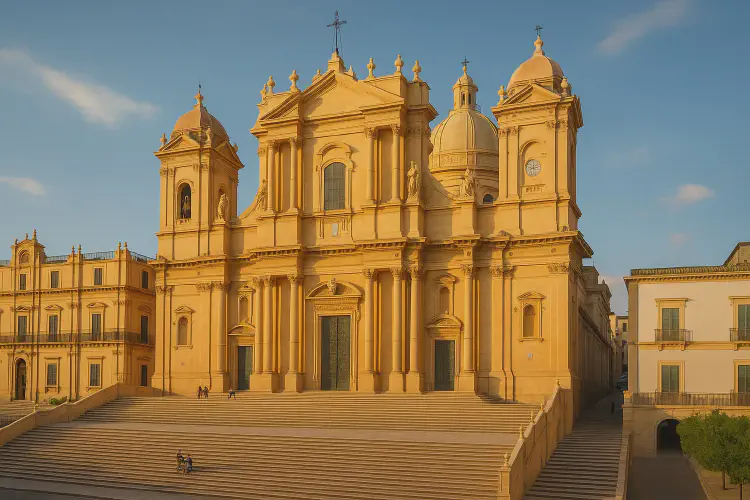Baroque churches and towns
After the catastrophic earthquake of 1693, southeastern Sicily rose from the ruins in dazzling fashion. The reconstruction gave birth to a new artistic era — **Sicilian Baroque**, a style of exuberant façades, intricate balconies, and theatrical piazzas that turned cities into masterpieces of light and stone.
- Visit Sicily
- 3 min read

Baroque Churches and Towns — Sicily’s Rebirth in Stone
🏛️ Historical Background
In January 1693, a massive earthquake devastated southeastern Sicily, destroying over 40 towns and killing tens of thousands. Out of this tragedy came a period of extraordinary creativity. Guided by local architects like Rosario Gagliardi and Andrea Palma, Sicilians rebuilt their towns in the Baroque style, blending grandeur with local limestone’s warm glow.
This reconstruction transformed Sicily’s landscape, giving rise to a unique regional variation of Baroque art characterized by curved façades, cherubs, ornate balconies, and bold symmetry. In 2002, the Late Baroque Towns of the Val di Noto — including Noto, Ragusa, Modica, and others — were designated a UNESCO World Heritage Site.
🌆 The Essence of Sicilian Baroque
Sicilian Baroque differs from its Roman counterpart through:
- Local materials: soft golden limestone and volcanic stone.
- Vertical façades: dramatic staircases leading to churches perched on hills.
- Playful ornamentation: putti, masks, and swirling columns.
- Light and shadow: façades designed to glow at sunrise and sunset.
The style reflects Sicily’s cultural diversity — blending Spanish exuberance, Italian craftsmanship, and local flair.
🕍 Most Beautiful Baroque Churches and Towns
1. Noto
Often called “the capital of Sicilian Baroque.”
- Noto Cathedral (Cattedrale di San Nicolò): rebuilt in the 18th century, it dominates Corso Vittorio Emanuele with an elegant dome and twin towers.
- Church of San Domenico: designed by Rosario Gagliardi, known for its sinuous façade.
- The entire town was planned as a Baroque ideal — symmetrical, luminous, and harmonious.
2. Ragusa Ibla
A maze of stairways, domes, and terraces.
- Duomo di San Giorgio: the town’s crown jewel, designed by Gagliardi, features a sweeping staircase and an iconic dome.
- Church of San Giuseppe: its curved façade mirrors that of San Giorgio, symbolizing architectural unity.
- Ragusa Ibla glows gold at sunset — one of Sicily’s most photogenic towns.
3. Modica
Built on two hills divided by a gorge.
- Cathedral of San Giorgio: a towering example of Baroque theatricality with 250 steps leading to its door.
- Cathedral of San Pietro: decorated with statues of apostles along the grand staircase.
- The interplay of churches and cliffs gives Modica a cinematic feel.
4. Scicli
A smaller but equally stunning Baroque gem.
- Church of San Bartolomeo: framed by cliffs and palm trees.
- Via Francesco Mormina Penna: a UNESCO-listed street lined with palazzi and churches.
5. Catania
Rebuilt entirely after the earthquake in lava stone, giving it a darker, dramatic tone.
- Cathedral of Sant’Agata: dedicated to the city’s patron saint.
- Via dei Crociferi: a remarkable street lined with Baroque churches and monasteries.
6. Palermo’s Baroque Churches
While Palermo predates the 1693 reconstruction, its 17th-century churches reflect a parallel Baroque spirit:
- San Domenico, Santa Caterina, and Gesù (Casa Professa) showcase exuberant stucco, marble, and gilded interiors.
🧱 Architectural Highlights
Key features of Sicilian Baroque design include:
- Scenographic staircases leading to elevated churches.
- Carved balconies supported by grotesque masks or cherubs.
- Twisting columns and curved façades that create movement.
- Warm limestone tones that shift with the light.
These architectural elements weren’t merely decorative — they expressed faith, resilience, and the rebirth of communities after devastation.
🎭 Festivals and Living Baroque
The spirit of the Baroque still animates Sicilian life:
- Infiorata di Noto: streets covered in flower mosaics each May.
- Saint George and Saint Peter festivals in Ragusa and Modica feature fireworks, processions, and music.
- Evening walks through these towns feel like stepping onto a Baroque stage.
🧭 Summary
The Baroque churches and towns of Sicily are monuments to rebirth — born from tragedy yet filled with light. Their ornate façades and sweeping staircases tell a story of faith, artistry, and resilience. From Noto’s golden streets to Ragusa’s glowing domes, Sicilian Baroque stands as one of Europe’s most stunning architectural legacies — a celebration of beauty rising from the ashes.